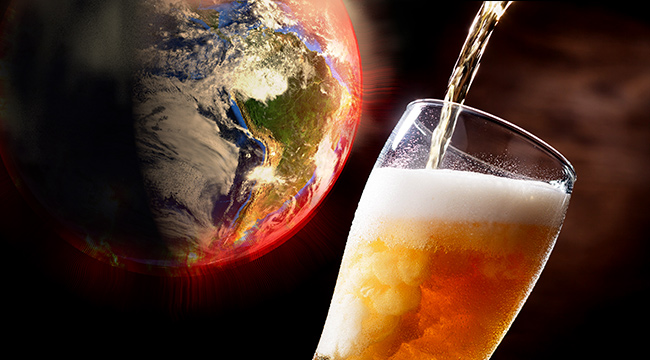
Water, barley, hops, and yeast. To many beer purists, these are the four ingredients, and the only four, that are allowed in beer. Most brewers are a bit more open-minded about what goes into their beers, of course. But climate change might soon make those four ingredients too expensive to drink.
NASA’s projections for the future include warmer winters, more intense hurricanes, droughts, and more importantly, vast shifts in the crops we grow, the resources we have at our disposal, and how we’ll have to manage them. Here’s what’ll take their place:
Water
Let’s deal with water, first. That the planet is approaching a water crisis is hardly news. By 2025, 1.8 billion people will experience an absolute water scarcity, and most of the rest will be under “water-stressed” conditions, and that will mean drastic shifts in the water we use and what we use it for. If you think your favorite craft beer is on the priority list, guess again.
The recent drought in California meant craft brewers had to come up with a string of inventive ideas, ranging from Fallbrook Brewing’s extensive efforts to recycle and conserve water to Bear Republic having to withdraw from distribution and dig two new wells in the town of Cloverdale.
Long term, though, beer will have to be made from “recycled” water. Whether that’s Stone’s sewage water beer, Maverick’s more extensive greywater plan, or more filtering processes, odds are, the beer you drink won’t be coming from the mountain streams of those Coors ads.
Barley
But beer will always be brewed from barley, right? No, probably not. Cereal grains haven’t been farmed with an eye to surviving climate change and it’s estimated that the impact will mean that products we generally use for a multitude of other applications — like your drafts — will be kept for people to actually eat. Climate change has been altering how we grow food for years, flooding coastal agricultural lands, making some areas where people grow food drier, and making others wetter.
While America grows a lot of barley, the problem is that most of the barley we grow is malted to make alcohol like beer. As some regions begin to suffer from weaker crop yields, demand for food crops will go through the roof.
That doesn’t mean that grain won’t be used in beer. Sorghum, for example, which is used in gluten-free beers, is hardy stuff that can deal with climate change, and American farms already grow a lot of it, mostly to feed to cows. Beef is probably off the menu thanks to climate change, but that’s another post; suffice it to say we’ll have plenty of sorghum to brew with. Oats and millet might also be good candidates. But even macrobrew staples rice and corn, might all be off the brewmaster’s bill if climate change runs completely amok; we’ll simply need them to feed people, not make beer.
Hops
Still, the worst disaster for beer fans will be what happens to hops. It’s a good thing IPAs are declining in popularity, because hops will be among the biggest victims of climate change. Between the challenges of the water usage of the crop and the fact that you can’t really eat hops, it’s just not going to be a priority crop on our hotter, drier Earth, and some varieties might not survive anyway. Hops might be on the way out a bit already; as demand has risen, cost has skyrocketed, especially for popular varieties like Cascade.
That doesn’t mean beer won’t have bitter, floral or other notes, but it’ll come from gruit. Gruit is a mix of herbs, ranging from mugwort and horehound to juniper berries and ginger, that added those herbal, bitter notes that beer drinkers love so much before brewers discovered the usefulness of hops as a flavoring agent. Hops had the advantage of being a preservative as well. So, as beers lose their hops, they’ll gain more chemical preservatives, since hops naturally keep beer perky and fresh.
You can also expect more sours. The bacteria that create the acids giving sours their tartness don’t care much about climate change, and sour beers tend to keep well, depending on how they’re bottled. The rising cost of hops, and cheapness of making sour beer, may already be contributing to the rise of sours.
Yeast
https://www.instagram.com/p/BVpgSZcgv2U/?tagged=yeast
If you like yeast, we have good news, well… sort of. Yeast is pretty hard to kill, and while climate change may alter wild yeasts, something Belgian brewers have been struggling with, yeast, for the most part, is just going to go about its yeasty business eating sugars and making them into bubbles and alcohol. So unless you exclusively drink lambics and sours brewed by Belgians, the yeast won’t change.
People often look too closely at the personal when considering climate change. Melting ice caps and rising sea levels can often feel far away, or have effects so gradual we just incorporate them into our lives without noticing. So it might be with the beer you have in your glass. Right now, maybe a hoppy beer costs a little more, or maybe one day there’s one least wheat beer on tap. But little changes add up; a decade from now, you might decide you’re in the mood for an IPA or a witbier and discover it’s twice what the other beers at the bar cost, or it’s simply not there at all.
If we don’t pay attention, if we don’t act now, much of what defines beer culture, and some of our best beers, will slip away from us without so much as a goodbye. Sure, the planet will die too and the few remaining humans will live in a baked wasteland, but we’re getting off track. The beer! The beer!






